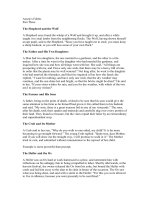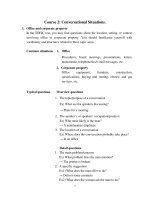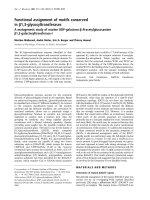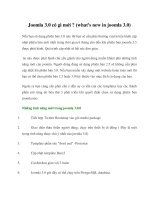Minerals in geology 3
Bạn đang xem bản rút gọn của tài liệu. Xem và tải ngay bản đầy đủ của tài liệu tại đây (2.25 MB, 18 trang )
The Amazing World of
Minerals
Photos: www.johnbetts-fineminerals.com
Cueva de los cristales, Naica Mine,
Mexico
•
•
•
•
•
•
Series of gypsum filled caves
found at 950ft depth in a mine
122ºF!! 100% humidity!!
Explorers and scientists must
wear refrigerated space suits
to avoid being boiled alive
Even with the suits they can
only remain in the caves for 10
minutes
Gypsum seems to have
formed in unusually saturated
geothermal fluids associated
with a nearby fault
Exploration continues today
Photos: La Venta Exploring Team
Why are minerals important?
Short Answer: You can’t live without them!
Bauxite
Aluminum
Diamond
Cutting tools, getting
married
Halite
Zeolites
Salt
Water purification,
catalysts, medicine
Feldspar
Ceramics,
porcelain
Quartz
Watches,
radios, glass
Uraninite
Nuclear power,
x-rays
Borax
Soap, cosmetics, fire
retardant, fiberglass, fertilizer,
insecticide, airplanes,
medicine!
Uses of minerals in geology
Determining
• Ages of rocks
• Tectonic environment
• Compositions of source magma
• Pressure and temperature histories of rocks
• Reaction rates
• Past strain recorded in rocks
• Paleomagnetism
• Economic ores
• The chemical make-up of the Earth and how elements
are exchanged
Mineral Identification
• Since every mineral is chemically and structurally
unique, every mineral has properties that can be used to
distinguish it from other minerals
• A major purpose of this class will be give you the
confidence to identify minerals in the field so you can
use them to answer geological questions
Common Properties for Mineral
Identification
• Color- many minerals have a characteristic color
– Ex: Epidote is almost always green
– Ex: Sulfur is almost always yellow
• However, minerals such as quartz, tourmaline and
garnet can be virtually any color
Quartz
Garnet
Tourmaline
Hardness
• Most used method is the Mohs Scale
• 1)Talc
2) Gypsum 3) Calcite
4) Fluorite
5) Orthoclase 6) Apatite 7) Quartz
8)
Topaz 9) Corundum 10) Diamond
• Minerals with a lower number will be scratched by
minerals with a higher number
• Mohs scale is relative (diamond is 10x harder than
corundum)
• Fingernail=2.5
Penny=3
Iron=4-5
Knife=5.5
Glass=6-7
Luster
• A description of the way light interacts with the surface of
a mineral or rock
• Luster descriptions include metallic, earthy, waxy,
greasy, glassy, silky, brilliant, dull, satin spar, soapy
Pyrite
Quartz
Talc
metallic
glassy
Soapy, pearly
Crystal Structure or Habit
• What shape is the crystal?
Bladed Tabular
Dipyramidal
Prism
Cube
Rhombohedron
Also descriptions like fibrous, platy, massive, equant,
acicular are helpful
Cleavage and Fracture
•
Cleavage occurs along specific planes of weakness in a mineral.
These planes are caused by the molecular structure of the mineral.
• Crystals with good cleavage like calcite or mica will always break
parallel to the same plane.
•
Number, quality and angular relationships between cleavage planes
are important
• Minerals with no cleavage like quartz
will fracture
– Conchoidal or uneven
Density (mass/volume)
• Low Density
High Density
Halite
Barite
Graphite
Galena
Streak
• Many minerals leave a characteristic streak color when
scratched across a porcelain plate
• Other minerals have no streak
Mineral Assemblages/Tectonic
Environment
• Minerals commonly occur with other
characteristic minerals
– Ex: Scarn minerals: Epidote, Calcite, Garnet,
Scheelite
– Ex: Hydrothermal sulfide deposits: Galena, Barite,
Sphalerite, Pyrite, Fluorite, Calcite
– Ex: Pegmatites: Tourmaline, Quartz, Lepidolite, Beryl,
Muscovite, Feldspar
• Some minerals occur in specific environments
– Ex: Zeolite minerals commonly grow in vesicles in
igneous rocks
– Ex: Evaporites commonly occur in desert playas
Fluorescence
• Some minerals glow in the presence
of either short or long wave ultraviolet
light. There are several minerals that
exhibit this property some of which are
calcite, diamond, fluorite, halite, scheelite
and willemite.
• Fluorescence occurs on the atomic level
in a mineral. The electrons of an atom each
have a certain energy level called their 'ground
state' (blue electrons).
• In fluorescent minerals, energy is absorbed by the atom increasing the
energy of the electrons, causing them to jump to the next energy level (red
electrons).
• This increase in energy level does not last long (approximately 10-8
seconds). When the electrons fall back to their ground state, the extra
energy is emitted from the atom in the form of visible light (green
sparkles).
Fluorescence
Diamond
Calcite
Selenite
Fluorite
Calcite with zincite
Other Properties used for ID
• Optical Properties
– Ulexite- fiber optic properties
– Calcite- double refraction
– Optical Microscopy
• HCl Acid
– Calcite- fizzes when acid is applied
• Twinning
– Orthoclase feldspar- Carlsbad twinning
– Plagioclase- Albite twinning
Other Properties used for ID
• Magnetism
– Magnetite- magnetic
• Smell
– Sulfur- rotten eggs
• Alteration/Weathering
– Hematite- rusts red
– Olivine- alters to orange mineral called iddingsite
• Taste
– Halite- salt
– If it’s orange/red and you eat it and it kills you it was
probably Orpiment/Realgar
Created by Nicolas Barth
2007
Geology 114A
University of California, Santa Barbara
Some images herein borrowed from
websites have not been credited









